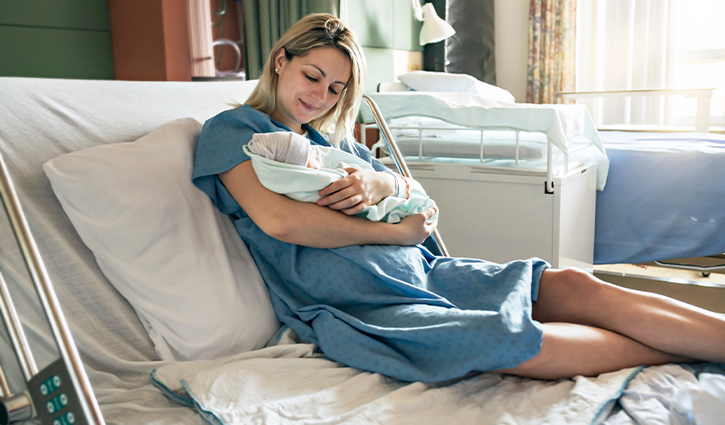

Having a baby is a big adjustment, not least of which is the changes that your body goes through. There’s a lot of talk about what to pack in the hospital bag, but women are often unprepared for caring for their body after a vaginal birth. It’s not because they haven’t planned ahead. It’s that it’s not really openly discussed.
So, we’re here to tell you the truth about postpartum recovery, and what you’ll absolutely need to pack in your recovery kit to help heal your vagina and relieve discomfort following birth.
Postpartum recovery – what to expect
‘Postpartum’ refers to the mother and her body during the period after birth. Here is what to expect:
- You’ll bleed from your vagina for up to 4 to 6 weeks. The blood is called ‘lochia’, and it’s bright red, heavy, and can have clots.
- After-birth pains, which is your uterus contracting towards its pre-pregnancy size, and can feel like labour or period pains. You might feel it more when breastfeeding.
- Pain, bruising, and discomfort from stitches after tearing, swelling, and varicose veins in your vulva. Your first bowel movements can be uncomfortable for these reasons too.
- Sore, cracked nipples and leaking breasts while you establish breastfeeding.
- Potential lower back pain and abdominal muscle separation.
How to plan for your postpartum recovery
If all that sounds overwhelming and a little scary, remember that you’ll be snuggling with your beautiful newborn, making it all worthwhile!
It’s also an excellent reminder that you’re going to need a support network during this period. It’s important that you plan for that as much as possible, too. Accept offers of help, outsource what you can, stock your freezer with nourishing meals, ask for help with household chores, pets, or older children. Print out our list of available professional advice and support for you and your baby’s health.
Your postpartum recovery kit essentials
The great news is that there are plenty of products out there to support your recovery and relieve pain, so get yourself a lovely bag, and pop these items in there. You’ll thank us!
Compression shorts or leggings
Compression recovery shorts or tights/leggings provide pain relief and postpartum support so that you can move more freely and speed up your recovery. They can also aid in the treatment of perineal trauma, episiotomy wounds, lower back pain, and abdominal muscle separation.
A peri bottle
Going to the toilet can be painful, so instead of irritating your skin further by using pressure and wiping with toilet paper, it’s much better to use water to gently cleanse the area. A peri bottle is designed for this very job by spritzing water to your stinging areas.
Maternity pads
You’re going to need a LOT of these initially, and here’s what to look for in pads designed for postpartum bleeding: they should be soft, long and wide for better protection while lying down, super absorbent, and feature an adhesive panel to help it stay in place. If you’d rather not use pads, you can choose to wear washable period underwear that’s specifically for post-birth bleeding.
Mesh panties
Maternity pads and padsicles (more on these next) are large so you’ll be needing some stretchy, high rise underwear to hold them in place. Mesh panties are the perfect solution: they don’t apply pressure to your tender areas, and they’re breathable to help prevent infection, and soft for ultimate comfort.
Padsicles
Short for pad and popsicle, these will become your best friend. They’re sanitary pads that are chilled in the freezer and worn in your mesh undies, providing some wonderful, sweet relief. They help to reduce swelling, bruising, and soothe the discomfort associated with haemorrhoids and stitches. You can DIY them at home, or even better, you can get yourself a premade supply.
Witch Hazel
Witch Hazel is like a magic potion – it’s a plant with renowned healing properties, and is fantastic for reducing swelling, managing haemorrhoids, and fighting bacteria. You can spray some in your padsicle, adult nappy, maternity pad, or alongside the peri bottle when you’re cleansing your sensitive areas.
Maternity bras and tops
For breastfeeding mummas, you’ll need soft, comfortable, easily accessible bras, tanks, tops, and pyjamas. You’ll want them to be stretchy as your postpartum weight and bra size changes.
Probiotics
Probiotics can help to restore and maintain the balance of ‘good’ bacteria in the gut microbiome, and if you’re breastfeeding, certain breastmilk-isolated strains can help to reduce the symptoms and occurrences of mild mastitis.
Nipple balm
It’s not uncommon to experience sore, cracked, blistered, and even bleeding nipples in the early weeks of breastfeeding. A natural nipple balm will help to form a protective barrier at the same time it soothes any discomfort. Use only water to wash your breasts, and expose them to air to dry before covering them again.
Breast pads
When your milk comes in and you’re establishing your supply, you might experience leaks. Absorb the drips before they soak your clothes, using some reusable or disposable breast pads. If you don’t want to waste any of that liquid gold, you might also like to use a manual breast pump or milk collectors that sit inside your bra.























